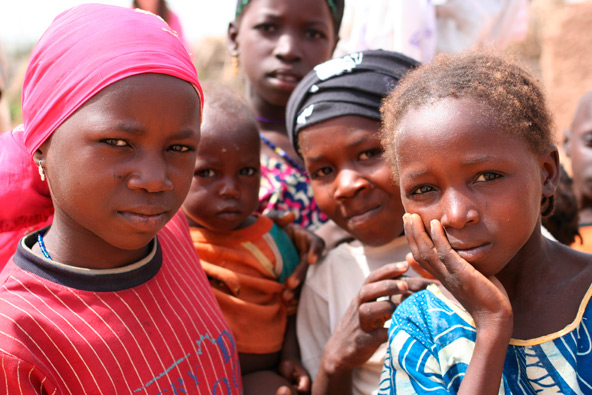
TOLOBOYE, Niger — Saâdi Zakari is a single mom. Her husband left their village two years ago, looking for work in neighboring Nigeria and has yet to return.
He could be dead, he could have started another family or he simply could be stuck without enough money to come home. Whatever the case, Zakari’s two children are hungry and it’s up to her to feed them.
Many men from villages like hers in West Africa’s Sahel region journey to neighboring countries like Nigeria or Libya looking for work. Prolonged drought has led to insatiable famine in the agricultural nation.
The lean season, which leads up to the harvest, is particularly harsh in landlocked countries like Mali, Niger and Burkina Faso. The Sahel is a strip of transitional land between the Sahara desert and the tropics. Over time, these dry regions have expanded to cover more of West Africa.
Niger is one of the world’s poorest countries. Zakari has relied on cash-for-work and a local lending community to sustain herself and her children. And as it has been for centuries, she can rely on the strength of her village.
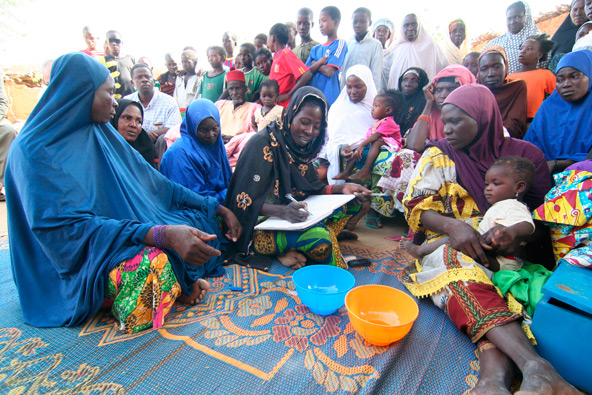
Small Internal Lending Communities
To cope with the drought, many farmers resorted to taking loans, which they expected to pay off the following year. But year after year, the drought continued and farmers are now struggling to climb out of debt.
“It would be good to be independent of the rainfall,” said Hamadou Abdou, who has traveled to Nigeria for extra work in the past. “We’ve had years that have been catastrophic.”
In 2005, a food crisis caused 3.5 million to be malnourished. Abdou’s family had little to eat and at one point he stopped eating so that his children could.
Malaria is also a constant concern in the region and is the number one killer of children. Violence in Mali has also driven refugees to both Niger and Burkina Faso, complicating an already stretched relief effort.
With men leaving the country to find work, West African resilience relies heavily on the strength of women. Women are the primary educators and are quickly becoming a source of economic stability.
Zakari, for example, is part of a Small Internal Lending Community (SILC) implemented by Catholic Relief Services. These are savings-led microfinance programs of about 20-25 self-selected people.
Each week, members pitch in a given amount to the community savings. These monies, in turn, are loaned to group members. The vast majority of group members in Africa and in other countries are women, who are more likely to pay back loans than men and would rather not partner with them.
“Women prefer men not to be in SILC groups, but so few women are literate they end up letting men get involved,” said Ousseini Sountalma, with CRS Niger.
Relief efforts tend to entrust mothers with money because they’re more likely to use it for the whole family, not just themselves.
“The men are very happy,” said Fati Halidou, a member of a SILC group in Tillaberi. “When they run out of money, now they ask us.”
SILC groups also have a social fund, which goes to pay for medical bills, school needs, ceremonies, funerals and household essentials.
When women borrow money from savings, they try to make more money with it. They’ll buy a big bag of grain, say, and sell portions of it to others. They also buy seeds or cattle.
“It isn’t easy to raise the amount we need to invest,” said Bibata Daouda, president of the SILC group. Those who partake in the loans and pay them back receive extra money back at the end of the year.
SILC programs have deep roots in Burkina Faso, too, according to Jacque Kaboré, who heads the CRS program there. “The households that are the most vulnerable are those headed by single mothers,” he said. “These communities give mothers a chance.”
Farmers use the community funds and vouchers to diversify crops. Farmers are more apt to sustain themselves knowing that certain seeds will yield more than others and certain crops will fetch a higher price.
The price of okra is on the rise. It grows in the Sahel and is in constant demand in Niger, so farmers are growing more of that. Market gardening leads not only to more profit, but also better nutrition.
Sesame and onion are other crops that also fetch higher prices.
If farmers wait to sell harvested onions at an opportune time, they’ll make more money. CRS has helped villages build places to store the onions while they increase in value.
Fotouma Soumoune, who is involved in a sesame seed project in Tillaberi, said CRS encouraged farmers to try different varieties of sesame seed. They ran a couple trials and discovered a different seed with higher yield.
“At first we started to sell the seeds themselves at a somewhat low price,” Hamata Adamou said. “But then we began to produce sesame oil, which sells for a lot more.”
Older women run the CRS-funded machines that blend the seeds and produce the oil. The village farmers also learned it was more efficient to let the pods dry before removing the seeds.
The women now make sesame seed biscuits, which are high in protein. And children think they’re delicious.
“A lot has been done, but we hope to produce a lot more,” Adamou said, explaining they would like to acquire better machines to produce oil.
Reclaiming the Sahel

More efficient farming isn’t going to cut it, though. Years of drought have left less and less farmable land in West Africa. Without a harvest, farmers began selling wood to make extra money.
On highways in neighboring Burkina Faso, boys ride donkey-led wagons full of skinny chopped down trees. On their way to the capital, Ouagadougou, the wagons are full; on their way back to the village, the wagons are empty but for the occasional napping child.
Having fewer trees led to more top soil erosion. When it does rain, the water runs off the hard, dry earth, oftentimes flooding villages.
Spurred on by cash-for-work programs, farmers are reclaiming the land, digging dikes and half-moon ditches for a few dollars a day. These crevices capture the rainwater and give it time to penetrate the sometimes rock-hard Sahel terrain.
At the base of the half-moons and along the dikes, the farmers plant trees. In two years, the acacia Senegal trees they plant will produce $6 worth of Arabic gum a year. Unplanted vegetation springs up, too.
“Without the dikes, this would all get washed away,” said Sountalma of CRS Niger. The trees, which require little water to thrive, also combat wind erosion.
“Once the trees were grown, the government came and showed us how to cut them to extract the Arabic gum,” said Seyrui Naada, who heads the acacia tree effort in the Takare village. He began heading the program after he returned from Nigeria.
“The best time to cut them is during the cooler months, in November and December,” he said.
During difficult times, the village lets their animals eat the leaves off the trees. They’ve also been receiving a lot of curious visitors from surrounding villages, which they like, he said.
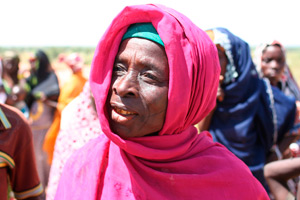
In this village, a typical man will start his day at 6 a.m. and work the fields. He takes a break at noon to eat, and then goes back to work until 6 p.m. He comes back home, prays and eats dinner.
Women wake up at 6 a.m. to pound grain. Then, they prepare the lunch they’ll bring to the men in the field.
They stay in the field to work for some of the afternoon alongside the men. The women are also responsible for sweeping the house inside and out, for getting water from the drilled well and for dinner. They’ll fall asleep under mosquito nets if they’re lucky.
Tounie Guero, a woman in the village, said girls begin to pound grain at 8. She spoke with an infant fastened to her back.
Mills to grind the grain, which CRS provided, have greatly reduced the women’s work. Boys will begin working in the fields at 10, so long as they aren’t in school.
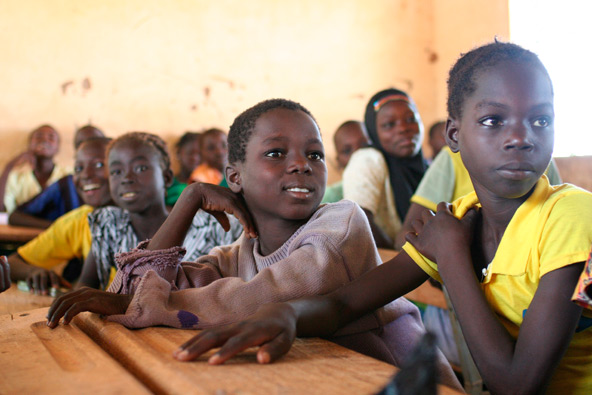
Feeding the mind
“When you pass fourth grade, you see a drop off in enrollment,” said Neda Sobhani, who coordinates Food for Education for CRS in Burkina Faso. The country is the subject of CRS Rice Bowl during the first week of Lent.
CRS’ Food for Education program provides food for school children and gives parents an incentive to keep students attending. Students are sent home with a ration of wheat, lentils, oil and corn.
Mothers have a vital role to play in early detection of malnutrition, but the community can also help.
“We know this program won’t last forever, so we’re implementing an exit strategy,” Sobhani said. “The community is pulling together to provide meals for students on their own. Sometimes all a community needs is for you to break it down and explain it.”
There’s also a mentor program, which matches young girls with women who check in on them, help with homework and talk about girl issues. Girls start to drop out of school around puberty, Sobhani said.
“We as mentors are getting girls to complete their primary education so they can make an impact on society,” said Mariam Sabadogo. “When I visit one of the girls, I might bring a book and ask questions about what she learned that week.”
Such programs are rocking traditional stereotypes.
“We didn’t send girls to school because of ignorance,” said Idrissa Sabadogo, a parent. “We used to think girls weren’t as smart as boys, but now we know it’s just the opposite.”
Boys, according to some parents, are paying more attention than ever. They’re scared they may get left behind.
“If someone is washing your back, you need to focus on washing your belly,” said Rasmame Sabadogo, who directs a school in Burkina Faso. “So we are applying what we’ve been taught.”
Still, the drought drives many students to drop out of school and travel to places like the costal nation Cote d’Ivoire to the south or to search for gold in mines in Burkina Faso.
‘Village spirit’
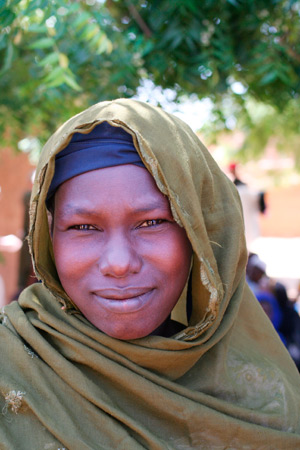
Zakari doesn’t know the fate of her husband and could well be providing for her children as a single mother for a long time. But she certainly isn’t alone.
The name of her village — Tolkoboye — means “recognizing the poor.” It’s been a tradition for centuries to help those in need. The Tolkoboye tradition hasn’t changed despite the drought.
“When people from outlying areas come, we gather what we can,” said Hamidou Yayé, one of the villagers. “What people usually need is food and sometimes clothing. We all give what we can and that’s enough to help those who arrive asking for help.”
Jacque Kaboré of CRS Burkina Faso said the same is true for the Burkinabé.
“No one will tell you they’re happy to leave a village,” he said, referring to the many that seek work in surrounding areas. “When they do leave, it’s because circumstance forces them to leave.”
He said sharing is part of the culture, something he names a “village spirit.”
“You can have something to eat, but that’s not enough,” Kaboré said. “You want to be where you are respected. Food is just a tool for us. What’s important is community.”
Rice Bowl
Each Year, Catholic Relief Services kicks off its appeal during Lent. The CRS Rice Bowl helps millions enrich their Lenten journey and “draw closer to God in preparation for Easter.” This year, CRS is Rice Bowl will benefit Burkina Faso, among other countries. The program will raise awareness of the severe conditions farmers face after years of drought.
Learn more on the CRS website:






